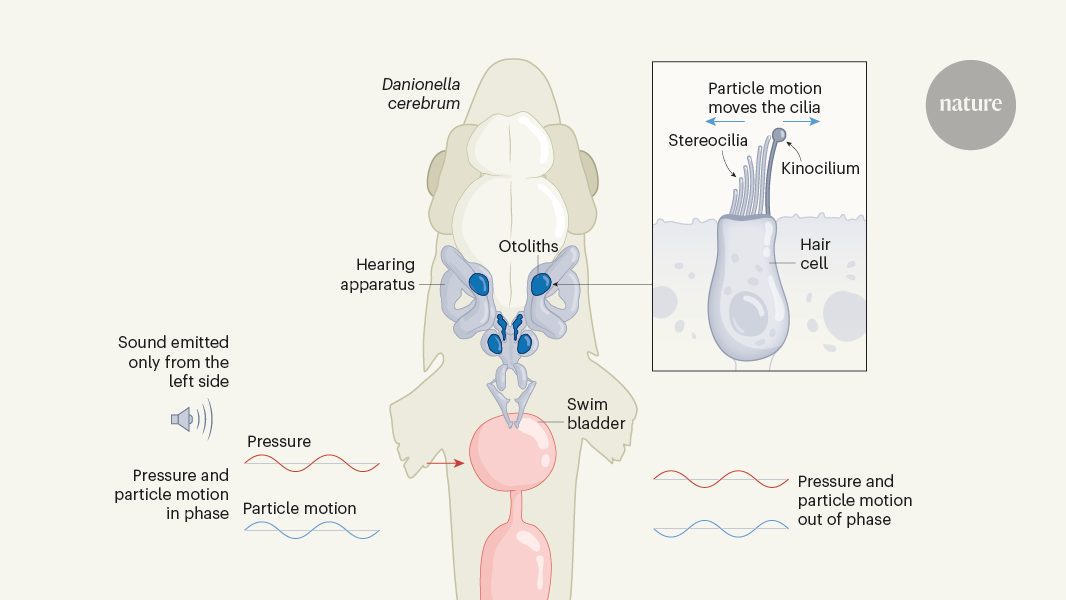How Fish Use Pressure and Particle Motion to Detect Sound Direction
Keskeiset käsitteet
Fish can detect the direction of sound using a combination of pressure and particle motion sensing mechanisms.
Tiivistelmä
The article discusses the mechanisms that enable fish to achieve directional hearing. Fish can sense the direction of sound using a combination of pressure and particle motion sensing.
The pressure sensing mechanism involves the swim bladder, which acts as an impedance matcher, amplifying the pressure component of sound waves. The particle motion sensing mechanism involves the inner ear and lateral line system, which detect the movement of water particles caused by sound waves.
By integrating the information from these two sensing modalities, fish can determine the direction of the sound source. This directional hearing ability is valuable for tasks like locating prey, avoiding predators, and communicating with conspecifics.
The article highlights the research by Veith et al., which sheds light on the specific mechanisms underlying this directional hearing capability in fish. Understanding these mechanisms can provide insights into the evolution and adaptation of auditory systems in aquatic vertebrates.
Pressure and particle motion enable fish to sense the direction of sound
Tilastot
None.
Lainaukset
None.
Tärkeimmät oivallukset
by Catherine E.... klo www.nature.com 06-19-2024
https://www.nature.com/articles/d41586-024-01509-3
Syvällisempiä Kysymyksiä
How do the pressure and particle motion sensing mechanisms work together to enable fish to accurately determine the direction of a sound source?
The pressure and particle motion sensing mechanisms in fish work in tandem to provide them with the ability to accurately determine the direction of a sound source. When a sound wave travels through water, it creates changes in pressure that are detected by the fish's lateral line system. This system consists of sensory cells that can detect these pressure changes, allowing the fish to sense the general direction of the sound. Additionally, the fish's inner ear contains otoliths, which are small particles that move in response to the vibrations caused by the sound wave. By analyzing the movement of these particles, the fish can further refine its understanding of the sound's direction. Therefore, the combination of pressure sensing through the lateral line system and particle motion sensing through the otoliths enables fish to accurately determine the direction of a sound source.
What are the potential limitations or challenges in the fish's directional hearing system compared to hearing in terrestrial vertebrates?
While fish have evolved sophisticated mechanisms for directional hearing, there are some limitations and challenges in their system compared to hearing in terrestrial vertebrates. One significant limitation is the attenuation of sound waves in water, which can make it harder for fish to detect sounds over long distances or in noisy environments. Additionally, the speed of sound in water is much faster than in air, which can affect the accuracy of determining the distance to a sound source. Furthermore, the presence of obstacles or varying water conditions can distort sound waves, making it challenging for fish to accurately pinpoint the direction of a sound. In contrast, terrestrial vertebrates have the advantage of air as a medium for sound transmission, which allows for clearer and more precise directional hearing compared to fish in aquatic environments.
How might the findings on fish directional hearing inform the development of bioinspired sonar or other auditory technologies?
The findings on fish directional hearing could provide valuable insights for the development of bioinspired sonar or other auditory technologies. By understanding how fish utilize pressure and particle motion sensing mechanisms to determine the direction of sound, researchers can design more efficient and accurate underwater acoustic systems. For example, bioinspired sonar systems could mimic the lateral line system and otoliths found in fish to improve directional sensing capabilities in underwater environments. Additionally, studying fish directional hearing could inspire the development of novel sensor arrays or signal processing algorithms that enhance the performance of underwater communication systems or autonomous underwater vehicles. Overall, the knowledge gained from fish directional hearing research has the potential to drive innovation in the field of underwater acoustics and contribute to the advancement of various auditory technologies.
0
